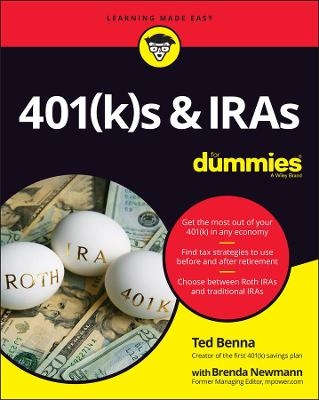
401(k)s & IRAs For Dummies
For Dummies (Verlag)
978-1-119-81724-6 (ISBN)
When you’re ready to start setting aside (or withdrawing) money for your retirement—whenever that might be—401(k)s & IRAs For Dummies is here for you! It covers both types of retirement plans because they each have valuable tax benefits, and you may be able to contribute to both at the same time. With the practical advice in this book, you learn how to manage your accounts, minimize your investment risk, and maximize your returns. Sounds like a win-win, no matter your situation or where you’re at in life.
Written by a well-known expert and ‘father of the 401 (k)’ , Ted Benna, 401(k)s & IRAs For Dummies helps you keep up with the ever-changing rules surrounding both retirement plans—including the rules from the SECURE and CARES Acts—and avoid the mistakes that can lead to higher taxes and penalties. Additional topics include:
Tax strategies before and after retirement
Required distributions and how much you need to take
Penalties for taking money out early and how to avoid them
What happens to your or your spouse’s retirement plan after death or divorce
The rules for taking money out of an inherited plan
Methods for calculating required minimum distributions
Special tax benefits for conversions to Roth IRAs
How to recharacterize IRA or Roth contributions
Why IRA based plans are a better options for many small employers
Helping solo entrepreneurs and other small businesses pick the right type of plan
Whether you’re just starting to think about a retirement plan, planning when to retire, or you’re facing retirement, you’ll find useful and practical guidance in 401(k)s & IRAs For Dummies. Get your copy today!
Ted Benna is commonly referred to as the “father of 401(k)” because he created and gained IRS approval of the first 401(k) savings plan. Brenda Watson Newmann began her career as an Associated Press foreign correspondent and later moved to Silicon Valley as Managing Editor at 401k Forum/mPower.
Introduction 1
About This Book 1
Foolish Assumptions 3
Icons Used in This Book 4
Beyond the Book 4
Where to Go from Here 4
Part 1: The ABCs of 401(k)s and IRAs 7
Chapter 1: Explaining IRAs and 401(k)s 9
Exploring the Basics of Retirement Savings Plans 9
Getting down to 401(k) basics 10
Introducing IRAs 12
Comparing and Contrasting IRAs and 401(k)s 14
Accentuating the Positive 16
Saving up 16
Getting employer contributions 16
Chapter 2: Taxing Issues 19
Realizing the Reasons for Tax Breaks 19
What the government gains 20
What you gain 20
Talking Tax Terms 21
Earning your income 22
Combining your income 22
Adjusting your income with AGI 22
Figuring your marginal tax rate 23
Getting Credit for Contributions 24
Deducting IRA contributions 24
Paying attention if your spouse has a plan 25
Earning extra credit according to income 27
Taxing Income at Retirement 28
Staying Alert to Changes in Tax Law 31
Chapter 3: Naming Beneficiaries and Planning for the Future 33
Deciding Who Gets Your Savings When You’re Gone 34
Detailing the Distribution 35
Talking Timing and Taxes 36
Passing along Company Stock 37
Starting the Roth Clock 39
Qualifying Your Charitable Giving 39
Giving a good QCD 40
Linking RMDs and QCDs (and minding your Ps and Qs) 40
Giving tax free 41
Being a Beneficiary 42
Deciding — or being told — what to do with the money 42
Saying no to the money 43
Stretching an inherited IRA 43
Part 2: 401(k) Basics 45
Chapter 4: Checking the Benefits of a 401(k) 47
Realizing What a 401(k) Does for You 48
Lowers how much tax you pay 49
Gets you matching funds from your employer 53
Makes room for a little something extra: Employer non-matching contribution 55
Allows you to save without tears 56
Vesting: When Your Employer’s Contribution is Yours to Keep 57
Vesting of employer contributions 57
Making exceptions (You knew this was coming, right?) 58
Letting the Pros Work for You 59
Protecting Your Money 60
Meeting minimum standards 60
Avoiding losses in bankruptcy 61
Watching Out for Potential Pitfalls 62
Earning more may mean contributing less 62
Being at the mercy of your plan 62
Chapter 5: Signing Up for a 401(k) 63
Exploring Your Eligibility 63
Sometimes you play a waiting game 64
Sometimes you can’t join at all 65
Sometimes you’re automatically in 66
Making Your Entry Date 66
Deciding How to Invest Your Money 67
Chapter 6: Paying Attention to Administrative Issues 69
Figuring on the Fees 69
Finding the fees 70
Understanding the fees 71
Paying the fees 72
Paying extra for extra services 74
Checking on small business challenges 74
Considering Funding Issues 76
Making a mutual decision 76
Unwrapping wrap fees 77
Prospecting in the prospectus 78
Knowing What You Can Know 79
Working to Improve Your Plan 79
Upgrading investment performance 80
Searching out information 82
Questioning investment strategy 83
Chapter 7: Weighing Your Options When You Leave Your Employer 87
Taking Your Savings with You 88
A Rolling 401(k) Gathers No Taxes 88
Realizing that account size matters 89
Moving your money to your new employer’s plan 90
Waiting for the money to transfer 91
Leaving Money with Your Old Employer 91
Taking a Lump Sum 92
Taking Stock into Account 93
Part 3: Here Come the IRAs 95
Chapter 8: Investing in an IRA 97
Looking at the Basics of Your IRA 97
Staying traditional 98
Touching on Roth IRAs 99
Benefiting from a spousal IRA 100
Starting an IRA for a child 100
Setting Up Your IRA 101
Deciding where to invest your money 102
Opening your account 103
Maintaining Your IRA 104
Moving Your IRA 104
Chapter 9: To Roth or Not to Roth 107
Predicting Future Tax Rates 108
Calculating accurately 108
Talking tax breaks 109
The “Or Not to Roth” Section 110
Taking Money Out of Your Roth IRA 111
Converting to Roth 112
Chapter 10: Rolling Over an IRA 115
Rolling-Over Basics (How to Shake is Next) 115
Rolling through the Process 117
Rolling through a conduit 119
Rolling partially over 120
Rolling Roths with care 120
Calling a Roth Conversion: No, It’s Not a New Football Play 121
Paying 20 Percent 121
Part 4: Saving and Investing 123
Chapter 11: Setting Up Your Savings Plan 125
Targeting Your Retirement Date 126
Getting Your Hands on Your Money 127
Drawing on your Social Security 127
Tapping into other sources 131
Living the retirement life 133
Testing the waters in your gene pool 134
Developing Your Retirement Savings Plan 134
Cutting down on your expenses 134
Picturing your progress 136
Counting on compounding 140
Chapter 12: Determining How Much to Save 143
Improving Your Chances of an Ideal Retirement 143
Deciding How Much of Your Salary to Put Aside 144
Making use of your salary deferral agreement 144
Measuring your plan’s maximums 145
Being highly paid means different rules 146
Estimating what your budget can afford 148
Building Your Nest (Egg) 150
If you’re retiring in the near future 150
If your retirement is farther off 152
Using a retirement calculator 154
Chapter 13: Selecting Your Investments 155
Looking Over the Investment Menu 156
Money market funds: Show me the money 157
Keeping things reined in with stable value funds 159
Bonding your funds: Single portfolio seeks stable relationship 159
Deciding one and done: Balanced and TDF funds 160
Stock funds: A feather in your cap 160
Investing where you work: Company stock 164
Brokerage window: Don’t fence me in 165
Forging Your Own Investment Trail 167
Baking Your Asset Allocation Pie 168
Check your ingredients and avoid these common mistakes 170
Open the oven door once in a while to check your progress 174
Make sure that your pie complements the rest of the meal 174
Seeking Help from the Pros 175
Finding books and publications 175
Consulting a real live person 176
Going online for info 177
Going online for advice 178
Chapter 14: Taking Reasonable Investment Risks 179
Defining Some Investment Basics 180
Playing debt instruments and making equity investments 180
Taking a dip in the mutual fund pool 181
Watching the return of the mummy er money 182
Diversifying for fun and safety 183
Staying In It to Win It 185
Seizing the opportunity of a downturn 185
Buying more when prices are low 186
Classifying Different Types of Risk 187
Losing more than you can stand 187
Losing your entire investment 188
Owning too much company stock 189
Not having enough money to live on during your retirement 191
Understanding the Risk-Reward Relationship 191
Deciding How Much Risk You Can Stand 192
Part 5: Money In, Money Out 195
Chapter 15: Making Contributions 197
Checking Out How Much You Can Contribute 197
Gauging the limits of the law 198
Seeing what Uncle Sam allows (he’s extra generous if you’re 50 or older) 198
Paying attention to the percent-of-pay limit 199
Heeding limits on your personal IRA 200
Maxing Out Matching Contributions 200
Timing is Everything 201
Spreading out your 401(k) contributions 201
Spreading out your IRA contributions — or not 202
Chapter 16: Withdrawing Money Before You Retire 203
Taking Money from Your IRA 204
Accessing Your 401(k) Plan Money While Working 205
Facing Hardship with Your 401(k) at Your Side 206
Defining a hardship 206
Determining the amount 208
Calculating the tax you owe 209
Dipping into Your 401(k) Money to Buy Your First Home 210
Both a Borrower and a Lender Be 211
Giving one good reason 211
Figuring out how much you can borrow 212
Determining how much interest you pay 212
Paying the piper: Repayment rules 212
To Loan or Not to Loan (To Yourself, That Is) 213
Weighing a Hardship Withdrawal versus a Loan 214
Saying No to Yourself 215
Chapter 17: Managing Your Plans after Retirement 217
Looking Forward to Retirement 218
Decisions, Decisions: What to Do with Your 401(k) Money 218
Being older can save you money 220
Foiling the dreaded early withdrawal penalty 221
Leaving money with your former employer 222
Making Withdrawals from Your IRA 223
Paying Uncle Sam His Due: Required Withdrawals 224
Developing a Strategy to Deal with the Tax Man 227
Which comes first: Plucking the chicken or emptying the nest egg? 227
Dealing with that darned company stock 228
Managing Your Investments in Retirement 229
Live long and prosper 230
Stay practical 230
Managing Risk 231
Balancing investments 231
Buying an annuity 232
Consolidating Your Accounts 235
Tending to Your Nest Egg 236
Row, Row, Row Your Boat, Gently Down the Income Stream 237
Treating Your Home Like the Asset It is 239
Adding up the expenses 239
Making use of your equity 240
Part 6: Helping Small Employers 241
Chapter 18: Plans from a Small Employer’s Perspective 243
Putting in the Effort 243
Meeting Regular 401(k) Requirements is a Pain in the Pocketbook 244
Getting to know ERISA and her requirements 245
Dieting won’t help top heavy plans 245
Sticking up for the little guy: Nondiscrimination tests 247
Calculating the bottom line on employer contributions 249
Deciding on other bells and whistles 249
Comparing 401(k)s 250
Going it alone: The solo 401(k) 250
Choosing a safe harbor in a storm of requirements 251
Spelling out QACA 252
Finding Alternatives to a 401(k) Plan 253
Making it easy with payroll deductions 254
SIMPLE Simon met a pie man 256
Contributing the funds with a Simplified Employer Pension (SEP) 258
A Word about Cost 259
Chapter 19: Offering a 401(k) Plan 261
First Things First 262
Prioritizing employees: Being a fiduciary 263
Exploring the world of fees 264
Choosing a 401(k) Provider 267
Getting up close and personal — why you shouldn’t 268
Streamlining the process with outside help 268
Going to a third party (the second one was lame) 271
Choosing Investments and Advisors for Your 401(k) Plan 271
Small business seeking a 401(k) advisor 272
Selecting the investments 273
Figuring out what types of funds to offer 274
Wrapping Up a Package of 401(k) Plans 275
Joining Up: MEPs, PEPs, and PPPs 277
Seeking common ground: MEPs 277
Connecting PEPs and PPPs 278
A 401(k) is a Terrible Thing to Waste: Educating Employees 278
Chapter 20: Choosing a Plan for Your Business 279
Selecting a Plan That’s Right for You 279
Considering Real-Life Examples 282
Meeting a small business’s needs with a SEP 282
Reaching personal contribution goals with the SIMPLE plan 283
Adopting the standard 401(k) for a growing business 284
Attracting employees with a QACA 401(k) 285
Getting Credit to Set Up 286
Changing Service Providers 287
Part 7: The Part of Tens 291
Chapter 21: Ten + Two Ways to Save For Retirement 293
Join an Employer-Based Retirement Plan 293
Set Up Automatic Withdrawals 294
Start Young 294
Deposit Bonus Money in Your Retirement Account 294
Earmark $20 a Week for Your Retirement Fund 295
Deposit Your Tax Refund into Your Retirement Account 295
Cancel Subscriptions You No Longer Use 295
Refinance Your Mortgage 295
Shop for Better Insurance Rates 296
Resist Click Bait 296
Think Before You Spend 296
Reduce Your Transportation Costs 297
Chapter 22: Ten Questions about IRAs Answered 299
Where can I start an IRA? 299
Do I need to hire a broker or financial advisor to start an IRA? 300
How much can I contribute to my IRA? 300
What tax breaks do I get for having an IRA? 300
How do I take money out of my IRA? 300
How much tax do I have to pay when I withdraw money from my IRA? 301
What can I invest in through my IRA? 301
What’s the safest way to invest my IRA money? 301
Is my IRA insured? 302
Can I start an IRA for my spouse and/or children? 302
When do I have to start taking money out of my IRA? 303
Chapter 23: Ten Reasons to Participate in a 401(k) 305
You Can’t Afford Not To 305
The Stock Market Can Be Your Friend 306
You May Get Contributions from Your Employer 306
Your 401(k) Money is Placed Safely in a Trust 306
Any Plan is Better than No Plan 307
Your Account is Portable 307
You May Be Able to Take Out a Loan 307
Social Security Isn’t Enough 308
The Younger You Start, the More You Can Save 308
You Can Contribute More as You Get Older 309
Index 311
| Erscheinungsdatum | 21.12.2021 |
|---|---|
| Co-Autor | Brenda Watson Newmann |
| Sprache | englisch |
| Maße | 185 x 234 mm |
| Gewicht | 476 g |
| Themenwelt | Wirtschaft ► Betriebswirtschaft / Management |
| ISBN-10 | 1-119-81724-2 / 1119817242 |
| ISBN-13 | 978-1-119-81724-6 / 9781119817246 |
| Zustand | Neuware |
| Informationen gemäß Produktsicherheitsverordnung (GPSR) | |
| Haben Sie eine Frage zum Produkt? |
aus dem Bereich


